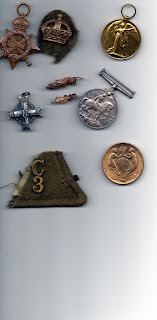

The final soldier remaining to be profiled in my blogs remaining from "The Friends of My Grandfather" photograph I inherited is Company Sergeant Major George Hyde Patrick #63712. He is the man on the extreme left back row. CSM Patrick has also proved to be the most difficult to profile genealogy-wise with an absence of photographs, web material and family histories. According to Cody family stories, my grandfather John Cody a Bridgewater CT resident, read a Boston newspaper recruiting for British and Commonwealth-born recruits for a Canadian Regiment. I have always assumed that this regiment was the Princess Patricia's Canadian Light Infantry, who apparently used newspapers across Canada and in New York and Boston to look for experienced military men. Thus he set out on a train for Montreal, accompanied by "about 20 other men". I believe George Patrick was one of these other men.
 |
| Grave of CSM George Patrick, Villiers Station Cemetery, France |
George Hyde Patrick claimed he was born in Halifax, NS on March 25, 1888. I have found the marriage in 1872 of his parents, Ralph Patrick (30), a printer and native of Pictou, and Annie E. Fenerty (25) daughter of a Halifax book-binder. The parents emigrated to Winthrup. MA soon after their marriage, between 1873 and 1881 and after the birth of Robert William Patrick in Halifax 1873. I believe I have located the family in the 1881 U.S. Census (without George) so I feel George Hyde Patrick, like my grandfather, lied about his country of birth as a citizen of the Commonwealth in order to attest into the CEF. George H. Patrick does show up in the 1900 U.S. Federal Census as living in Middlesex, MA. Nevertheless, on attestation in Montreal he was listed as a twenty-four year old, single, Insurance Salesman showing him mother, Annie E., as his Next of Kin.
 |
| Death Penny of George Hyde Patrick |

By December 1916, the 3rd Battalion was in the trenches in the relatively quite area of Souchez when on December 6, Company Sergeant-Major George Patrick was Killed in Action by a German sniper. While in the front line trenches at Souchez, Carency sector, he was "struck in the head by an explosive rifle bullet and killed instantly". The were no other fatalities in the 3rd Battalion that day. Several days later they participated in a daring and successful trench (about 90 men).
CSM Patrick was honourably laid to rest in Villers Station Cemetery, Villers-au-Bois, France. Interestingly, this cemetery is home to the brother of one of 3rd Battalion's most decorated men Lieutenant Edward Slattery as well as brother Private Michael Slattery #458270, 87th Battalion and the remains of four soldiers shot at dawn for desertion.
 |
| Birth Certificate George Patrick |
A mysterious man, a mysterious family, and a friend of my grandfather!
Thanks to Gary E. Switzer for filling in some blanks.
***NEW INFORMATION*** December 24, 2010
Thanks to friend Annette Fulford some of the mystery of George Patrick's life has been explained:
 |
| Medals of George Hyde Patrick #63712 |
George Hyde Patrick 23 years married Dora Haskell Hammond on October 31, 1911 in Somerville, MA. Apparently George did not want the fact known that he was married on attesting in Montreal November, 1914.
Harry Wallace Aiken married Elenore Stewart Patrick (George's sister) October 9, 1901 in Cambridge, MA This partially explains who Mrs. H.W. Aiken was. Why he sent a portion of his pay to his sister earlier on instead of his wife remains unknown.
***UPDATE***
August 20,2011
By the kind generosity of Diane Pentland granddaughter of George Hyde Patrick and husband Bruce, we now include photographs in the blog of George's medals, his Oak Leaf cluster for being Mentioned-in-Dispatches, government correspondence concerning his death and a brilliant photo taken in August, 1945 of his grave in Villiers Station Military Cemetery, France. A special thanks to Diane and Bruce.









































